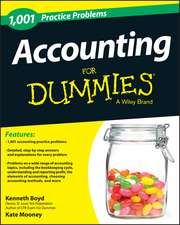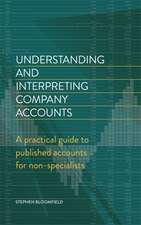Intelligent Systems and Financial Forecasting: Perspectives in Neural Computing
Autor Jason Kingdonen Limba Engleză Paperback – 28 apr 1997
Din seria Perspectives in Neural Computing
- 20%
 Preț: 986.66 lei
Preț: 986.66 lei - 20%
 Preț: 651.23 lei
Preț: 651.23 lei - 20%
 Preț: 1159.10 lei
Preț: 1159.10 lei - 20%
 Preț: 987.65 lei
Preț: 987.65 lei - 20%
 Preț: 648.44 lei
Preț: 648.44 lei - 20%
 Preț: 583.14 lei
Preț: 583.14 lei - 20%
 Preț: 989.79 lei
Preț: 989.79 lei - 20%
 Preț: 327.29 lei
Preț: 327.29 lei - 20%
 Preț: 339.34 lei
Preț: 339.34 lei - 20%
 Preț: 639.52 lei
Preț: 639.52 lei - 20%
 Preț: 648.59 lei
Preț: 648.59 lei - 20%
 Preț: 335.52 lei
Preț: 335.52 lei - 20%
 Preț: 646.80 lei
Preț: 646.80 lei - 20%
 Preț: 647.79 lei
Preț: 647.79 lei - 20%
 Preț: 641.49 lei
Preț: 641.49 lei - 15%
 Preț: 643.99 lei
Preț: 643.99 lei - 20%
 Preț: 329.91 lei
Preț: 329.91 lei - 20%
 Preț: 326.46 lei
Preț: 326.46 lei - 20%
 Preț: 398.07 lei
Preț: 398.07 lei - 20%
 Preț: 646.47 lei
Preț: 646.47 lei - 18%
 Preț: 786.36 lei
Preț: 786.36 lei - 20%
 Preț: 326.64 lei
Preț: 326.64 lei - 20%
 Preț: 650.73 lei
Preț: 650.73 lei - 20%
 Preț: 648.26 lei
Preț: 648.26 lei - 20%
 Preț: 652.73 lei
Preț: 652.73 lei - 20%
 Preț: 648.76 lei
Preț: 648.76 lei - 20%
 Preț: 335.18 lei
Preț: 335.18 lei - 20%
 Preț: 334.20 lei
Preț: 334.20 lei - 20%
 Preț: 335.88 lei
Preț: 335.88 lei
Preț: 643.50 lei
Preț vechi: 804.37 lei
-20% Nou
Puncte Express: 965
Preț estimativ în valută:
123.15€ • 128.09$ • 101.67£
123.15€ • 128.09$ • 101.67£
Carte tipărită la comandă
Livrare economică 15-29 aprilie
Preluare comenzi: 021 569.72.76
Specificații
ISBN-13: 9783540760986
ISBN-10: 3540760989
Pagini: 240
Ilustrații: XII, 227 p. 8 illus.
Dimensiuni: 155 x 235 x 13 mm
Greutate: 0.36 kg
Ediția:Softcover reprint of the original 1st ed. 1997
Editura: SPRINGER LONDON
Colecția Springer
Seria Perspectives in Neural Computing
Locul publicării:London, United Kingdom
ISBN-10: 3540760989
Pagini: 240
Ilustrații: XII, 227 p. 8 illus.
Dimensiuni: 155 x 235 x 13 mm
Greutate: 0.36 kg
Ediția:Softcover reprint of the original 1st ed. 1997
Editura: SPRINGER LONDON
Colecția Springer
Seria Perspectives in Neural Computing
Locul publicării:London, United Kingdom
Public țintă
ResearchCuprins
1 From Learning Systems to Financial Modelling.- 1.1 Introduction.- 1.2 Adaptive Systems and Financial Modelling.- 1.3 Time Series Analysis.- 1.4 Brief History of Neural Networks.- 1.5 Book Overview.- 1.6 Summary.- 2 Adaptive Systems and Financial Modelling.- 2.1 Financial Modelling.- 2.2 The Problems with Financial Modelling.- 2.3 Evidence Against the Efficiency Hypothesis.- 2.4 An Adaptive Systems Approach.- 2.5 Neural Nets and Financial Modelling.- 2.6 Genetic Algorithms in Finance.- 2.7 Summary.- 3 Feed-Forward Neural Network Modelling.- 3.1 Neural Net Search.- 3.2 MLP Training: The Model.- 3.3 MLP: Model Parameters.- 3.4 The Data.- 3.5 MLP: Training Parameters.- 3.6 Network Performance.- 3.7 Summary.- 4 Genetic Algorithms.- 4.1 Using Genetic Algorithms.- 4.2 Search Algorithms.- 4.3 GA Parameters.- 4.4 A Strategy for GA Search: Transmutation.- 4.5 Summary.- 5 Hypothesising Neural Nets.- 5.1 System Objectives.- 5.2 Hypothesising Neural Network Models.- 5.3 Occam’s Razor and Network Architecture.- 5.4 Testing Occam’s Razor.- 5.5 Strategies using Occam’s Razor.- 5.6 Validation.- 5.7 GA-NN Hybrids: Representations.- 5.8 Summary.- 6 Automating Neural Net Time Series Analysis.- 6.1 System Objectives.- 6.2 ANTAS.- 6.3 Primary Modelling.- 6.4 Secondary Modelling.- 6.5 Validation Modules.- 6.6 Control Flow.- 6.7 Summary.- 7 The Data: The Long Gilt Futures Contract.- 7.1 The Long Gilt Futures Contract.- 7.2 The LGFC Data.- 7.3 Secondary Data.- 7.4 Data Preparation.- 7.5 Data Treatment Modules.- 7.6 Efficient Market Hypothesis and the LGFC.- 7.7 Summary.- 8 Experimental Results.- 8.1 Experimental Design.- 8.2 Phase I — Primary Models.- 8.3 GA-RB Module and Combined Validation.- 8.4 Phase II — Secondary GA-RB Models.- 8.5 Phase III — Validation and Simulated LiveTrading.- 8.6 Controls: Analysis of ANTAS.- 8.7 ANTAS: Conclusions.- 8.8 Summary.- 9 Summary, Conclusions and Future Work.- 9.1 Motivations.- 9.2 Objectives: Neural Networks and Learning.- 9.3 Book Outline and Results.- 9.4 Conclusions.- 9.5 Future Work.- Appendices.- A Test Functions.- B ANTAS Outline Code.- C ANTAS Results.- References.






